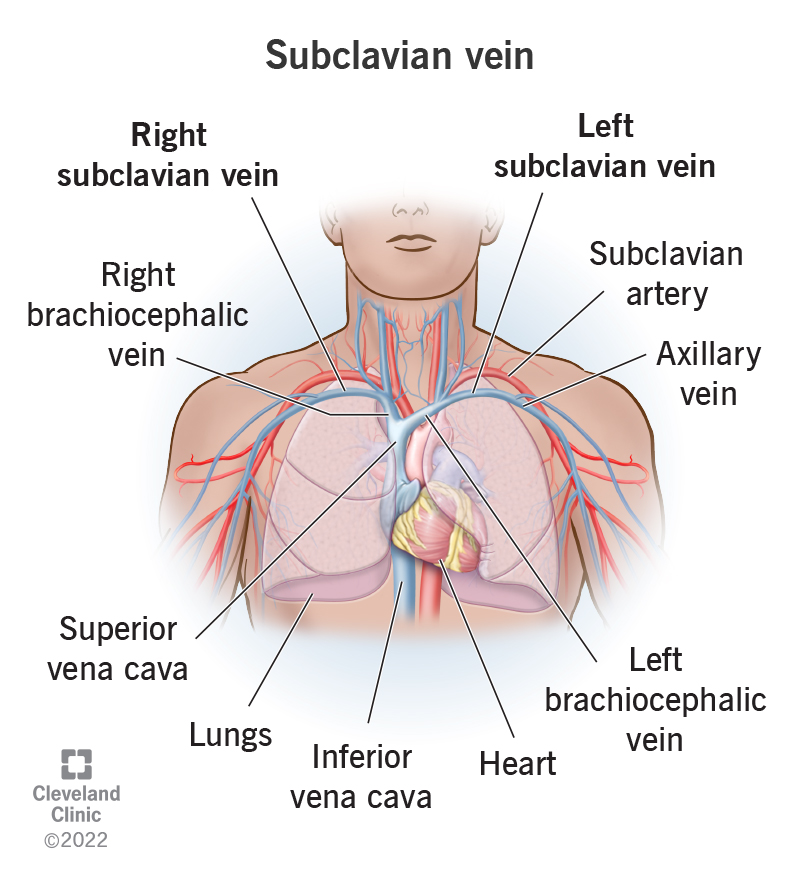Your right subclavian vein and left subclavian vein run just under your collarbone on each side of your body. They receive oxygen-poor blood from your axillary veins and carry it into your brachiocephalic veins. If your subclavian vein gets blocked, you can develop deep vein thrombosis. Symptoms are swelling, discomfort and heaviness in your arm.
Advertisement
Cleveland Clinic is a non-profit academic medical center. Advertising on our site helps support our mission. We do not endorse non-Cleveland Clinic products or services. Policy
Your subclavian vein is a deep vein that moves oxygen-poor blood from your upper body back to your heart. You have one on each side of your body. Your right subclavian vein carries blood from your right upper body. Your left subclavian vein carries blood from your left upper body.
Advertisement
Cleveland Clinic is a non-profit academic medical center. Advertising on our site helps support our mission. We do not endorse non-Cleveland Clinic products or services. Policy
Your subclavian veins help circulate blood through your upper body. That includes your arms, head and neck. Your blood moves through a complex network of blood vessels including arteries, veins and capillaries. Your arteries carry oxygen-rich blood to your organs and tissues. Meanwhile, your veins collect oxygen-poor blood that contains waste products. Your veins carry this blood back to your heart so it can gain more oxygen in your lungs and begin a new journey around your body.
To make it back to your heart, your oxygen-poor blood has to travel through a series of veins. Like roads in a small town, your veins connect with each other and branch off in different directions. But they all lead back to the same place (your heart).
Like many other veins, your subclavian veins run parallel with arteries that have the same name. Picture two narrow one-way streets that run side-by-side. Each subclavian artery carries blood away from your heart. And alongside it, your subclavian vein carries blood toward your heart.
Besides helping your blood flow, your subclavian veins also play a role in certain medical procedures.
Advertisement

Your right and left subclavian veins both run just below your collarbone (clavicle). Each subclavian vein begins near the top of your ribcage, next to your shoulder. It forms an arch that curves back down toward your heart. Picture a letter “m” that spreads across your chest, with the dip in the middle touching the top of your heart. Your subclavian veins are the top peaks of the “m.”
Your subclavian veins receive blood from the axillary veins, which collect blood from many smaller veins in your arms and hands. Your axillary veins are the outer edges of the letter “m”, leading up to your subclavian veins at the peaks. Your subclavian veins then drain into your right and left brachiocephalic veins. Those are the two curves in the middle of the “m”. At the middle dipping point, your brachiocephalic veins merge to form the superior vena cava. That’s the large vein that carries blood down into your heart.
Like your other veins, your subclavian veins are made of three layers of tissues and fibers:
Conditions that can affect your subclavian veins include:
If you have symptoms of these conditions, call 911 right away. These are medical emergencies that need immediate care.
There are several things you can do to keep your subclavian vein — and all your other veins — working at their best.
Advertisement
Your subclavian vein is an important part of your venous system. It helps move blood from your upper body back to your heart. If you have a history of vein issues like blood clots, talk with your healthcare provider. They’ll help you find ways to lower your risk of future problems.
Advertisement
Cleveland Clinic’s primary care providers offer lifelong medical care. From sinus infections and high blood pressure to preventive screening, we’re here for you.

Last reviewed on 08/03/2022.
Learn more about the Health Library and our editorial process.